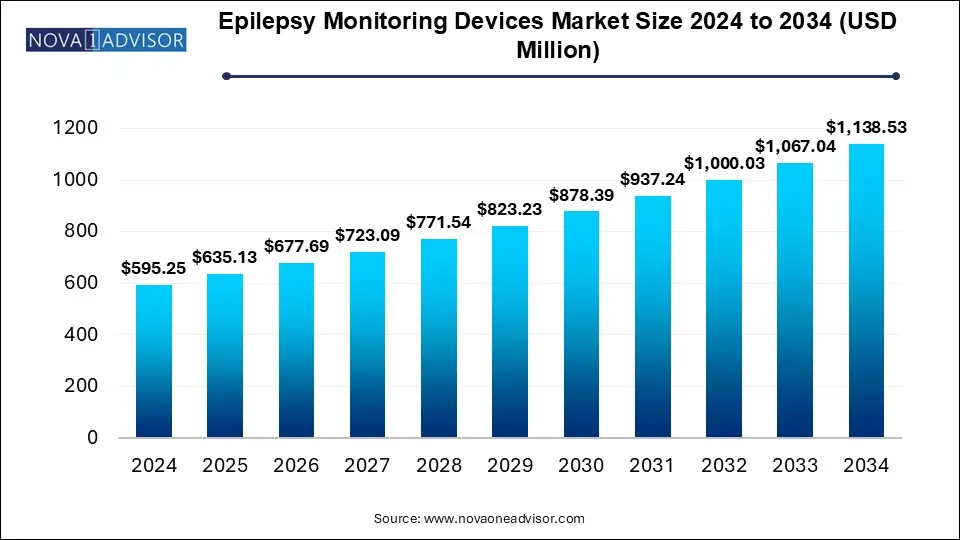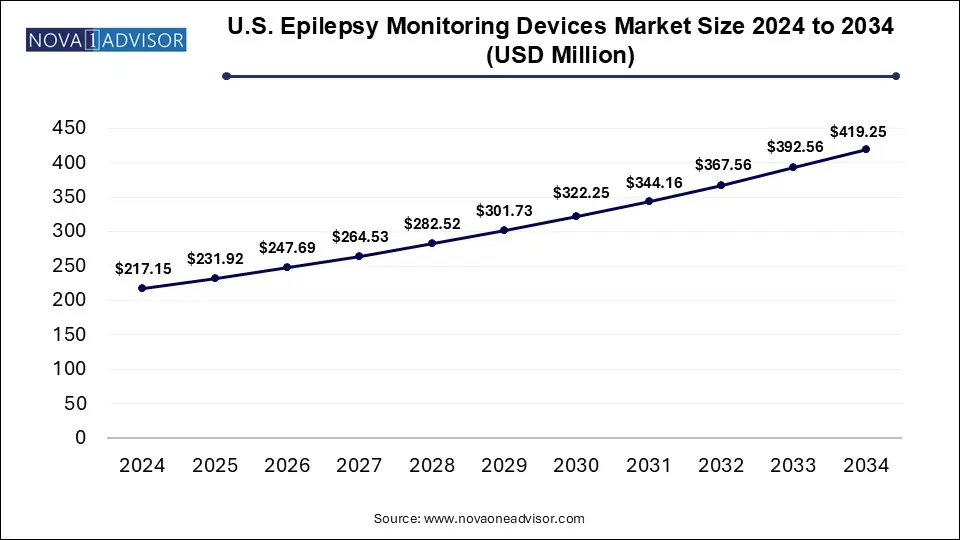The global epilepsy monitoring devices market size was valued at USD 595.25 million in 2024 and is expected to hit around USD 1138.53 million by 2034, growing at a compound annual growth rate (CAGR) of 6.7% over the forecast period 2025 to 2034.This growth is driven by increasing prevalence of epilepsy and advancements in remote monitoring technologies.

The U.S. epilepsy monitoring devices market size was valued at USD 217.15 million in 2024 and is expected to hit around USD 419.25 million by 2034, growing at a CAGR of 6.8% from 2025 to 2034.

North America dominated the market share in 2024 due to the presence of key industry players such as Medtronic, Natus Medical Incorporated, and Nihon Kohden. These companies have made large R&D investments which has resulted in cutting-edge product offerings. The region's dominance in the market is also a result of its high level of epilepsy awareness and high healthcare spending. The demand for epilepsy monitoring devices is further fueled by favorable reimbursement policies and robust government support for the management of neurological disorders. Wearable technology and AI powered monitoring systems are becoming more and more popular in the US and Canada supports market expansion as well.
Asia Pacific is fasting growing with rising in the epilepsy monitoring devices market. This increase is fueled by better access to diagnostics services, growing healthcare costs and growing awareness of managing epilepsy. It is anticipated that the use of epilepsy monitoring devices will increase dramatically as nations in this region improve their healthcare infrastructure. The market is also expanding more quickly due to the rising incidence of neurological conditions and the development of telemedicine solutions in developing nations like China and India the quick growth of this market is also a result of government initiatives to increase healthcare affordability and access.
With the increasing preference for home-based healthcare, remote monitoring solutions have gained traction in epilepsy management. By lowering hospital visits and guaranteeing ongoing patient care the covid-19 pandemic hastened the adoption of telehealth and remote monitoring systems. Doctors can remotely monitor patients thanks to gadgets like smartphone seizure trackers and mobile EEG headsets which save healthcare expenses and provide convenience. These systems also offer real time alerts which enhance patient safety by enabling emergency personnel and caregivers to take prompt action in the event of a seizure.
Growing Awareness & Early Diagnosis
Public health campaigns, medical conferences and educational programs have significantly increased awareness about epilepsy and the importance of early diagnosis. Previously ignoring minor symptoms many now seek medical attention sooner which results in better management and earlier detection. The accuracy of diagnosing epilepsy has also increased due to developments in neuroimaging and diagnostic instruments such as high-resolution MRI and video EEG monitoring. The market is growing as more patients choose monitoring devices as awareness rises.
| Report Coverage | Details |
| Market Size in 2025 | USD 635.13 Million |
| Market Size by 2034 | USD 635.13 Million |
| Growth Rate From 2025 to 2034 | CAGR of 6.7% |
| Base Year | 2024 |
| Forecast Period | 2025-2034 |
| Segments Covered | Product, End-use, Region |
| Market Analysis (Terms Used) | Value (US$ Million/Billion) or (Volume/Units) |
| Regional scope | North America; Europe; Asia Pacific; Latin America; MEA |
| Key Companies Profiled | NIHON KOHDEN CORPORATION; Medtronic; GE Healthcare; Koninklijke Philips N.V.; Compumedics Limited; Natsu Medical; Cadwell Industries, Inc.; BrainScope Company, Inc.; Seer Medical; Stratus |
Rising Adoption of Wearable Seizure Monitoring Devices
Wearable devices like smartwatches and EEG headbands are becoming popular for real time seizure detection and caregiver alerts. The integration of AI is enhancing their accuracy and user experience.
Growth in Telemedicine and Remote Monitoring Solutions
Telemedicine and remote monitoring allow epilepsy patients to share real time data with doctors via apps and cloud platforms. This reduces hospital visits while ensuring continuous seizure management.
Personalized Epilepsy Management with Big Data
Big data analytics help tailor epilepsy treatments by identifying patient specific seizure triggers. AI driven insights improve medication effectiveness and seizure control strategies.
Market Opportunity
Expansion of Wearable Seizure Monitoring Devices
Patients looking for comfortable real time monitoring options are driving up demand for smart wearable seizure detection devices. Businesses that invest in biosensor-based wristbands, EEG headbands and AI powered smartwatches stand to gain a substantial portion of the market. Accessibility can be increased especially in emerging markets by creating wearable technology that is more user friendly and reasonably priced for home monitoring.
Market Challenges
High Cost of Advanced Monitoring Devices
One of the biggest challenges in the epilepsy monitoring market is the high cost of wearable EEG devices, AI powered monitoring systems and cloud-based solutions. Many advanced seizure detection technologies remain unaffordable for patients in low- and middle-income countries. The lack of widespread reimbursement policies further limits accessibility, restricting market growth in cost sensitivity regions.
Social Stigma & Psychological Impact
Patients are discouraged from using wearable monitoring devices in public because epilepsy is still highly stigmatized in many cultures. The psychological effects of epilepsy such as depression and anxiety also have an impact on patients' compliance with ongoing observation. Businesses must concentrate on discrete easy to use designs and educational initiatives to encourage the adoption of epilepsy monitoring devices.
Conventional segment held the largest share in 2024 of the market driven by their high accuracy extensive clinical use and integration in hospitals and neurology centers traditional epilepsy monitoring devices such as EEG systems and video EEG monitoring have the largest market share. Their long-standing expertise in identifying and treating epilepsy guarantees their market dominance.
Wearable devices segment is expected to grow at the fastest rate in the market during the forecast period driven by patient preference for noninvasive real time seizure detection, growing demand for remote monitoring and technological advancements. Their uptake is further accelerated by the emergence of AI powered analytics and smartphone integration.
Hospitals & clinics segment held the largest share of the market as they provide specialized care, advanced diagnostic tools and continuous monitoring for epilepsy patients. Their access to trained neurologists and established healthcare infrastructure solidifies their leading position in epilepsy management.
Ambulatory segment is expected to grow at the fastest rate in the market during the forecast period driven by the rising trend of outpatient care, minimally invasive epilepsy treatments, and cost-effective alternatives to hospital-based procedures. Their ability to offer quicker, specialized interventions with reduced hospitalization times drives their increasing adoption.
This report forecasts revenue growth at country levels and provides an analysis of the latest industry trends in each of the sub-segments from 2021 to 2034. For this study, Nova one advisor, Inc. has segmented the Epilepsy Monitoring Devices Market
By Product
By End Use
By Regional